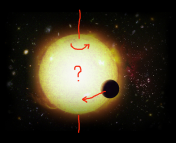First Author’s Institution: Institute for Particle Physics and Astrophysics, ETH Zürich, Wolfgang-Pauli-Strasse 27, 8093 Zürich, Switzerland
Authors: H. S. Wang, S. P. Quanz, D. Yong, F. Liu, F. Seidler, L. Acuña, S. J. Mojzsis
Status: Published in Monthly Notices of the Royal Astronomical Society [closed access]
In 1995, when I was born, there were only a few – hotly contested – exoplanets discovered. Now, there are close to 5000 planets found outside of our Solar System, and many more on the way. The growing population of known exoplanets mixed with the insatiable desire to know if humans are alone in the universe motivates astronomers to measure or estimate the properties of these planets and the environments they exist in.
Two important properties are a planet’s interior structure and its composition. These can influence many other properties of the planet, such as the presence of an ocean, magnetic field, or volcanoes with the ability to provide gas to the planet’s atmosphere. The only planetary interiors that we are able to directly explore are within our own Solar System. Even then, we have been limited to our nearest neighbors, Venus and Mars, with Venus being historically unkind to our technology (“The Venus Curse”). What, then, are we supposed to do when faced with so many exoplanets to characterize? How can we even begin to speculate at what their surfaces and interiors are like? The authors of today’s paper are taking steps to answer these questions.

These volatile delights have volatile ends
The authors base their method on a simple history of the Solar System. When the Earth was formed, it had roughly the same composition of elements as the Sun. Over time, the Earth has lost some of the elements most sensitive to vaporization (“volatiles” – e.g., hydrogen, nitrogen, etc); this is what the authors refer to as the “devolatilisation of Earth”, which is estimated by a factor reducing the Earth’s starting composition to its current composition. If we only focus on terrestrial planets that are like Earth – “exo-Earths”, mostly rocky planets within the habitable zone of their Sun-like host star – then the authors suggest that we can assume a similar loss process happens on those planets. The authors hypothesize that if we know how much of a certain element existed when a planet was formed (found by observing and measuring the composition of the planet’s host star), we can use the Earth’s depletion factor for that element to estimate how much of the element currently exists on that planet. The authors limit their analysis to rock-forming volatile elements, such as magnesium, iron, and silicon.
With the aim of exploring the diversity of exo-Earth interiors (compared to Earth’s interior in Figure 1), today’s authors choose 13 know exoplanet systems with Sun-like host stars which have precise chemical abundance measurements, including measurements for rock-forming volatile elements. Instead of looking at the actual planets around these stars, which vary in size, orbital distance, and potentially also depletion factor, the authors modeled what the interior of an exo-Earth hosted by each star would look like. They plugged the measured amount of rock-forming volatile elements and their depletion factors into the software ExoInt, which output the composition and structure of an exo-Earth core + mantle that best matches the inputs. The output exo-Earth composition and structure was then fed into the software Perple_X to estimate the mineral phases present within the mantle and the temperature, pressure and density of the planet’s interior. Rinse and repeat for all 13 exoplanet systems!
The main result is that most of the modeled exo-Earths show interiors similar to that of Earth itself. In Figure 2, the shaded parallelograms show the range of molecule-to-molecule ratios that could fit each exo-Earth. Both diagrams show how similar the mantle compositions of all the exo-Earth models are to that of Earth and Mars.Two systems, Kepler-10 and Kepler-37, contain more oxygen than the other systems; oxygen is important in determining how much iron is split between an exo-Earth’s mantle and core. Kepler-10 and Kepler-37 likely have smaller cores because of their higher oxygen content.

Implications for exoplanet astronomy
We are currently limited to assuming the depletion/devolatilisation factors of the studied exo-Earths are the same as Earth’s, although the authors show that interior structures may change when these factors are varied. The interior structure models are also limited to only considering a mantle and a one-component core – unlike the two components, inner and outer, that make up Earth’s core. Nevertheless, this work shows that astronomers can use currently available planetary radii and mass measurements along with host star compositions to estimate the interiors of terrestrial planets in the habitable zones of Sun-like stars; combining this with atmospheric observations from telescopes like Hubble and JWST brings us one step closer to finding Earth2.0!
Astrobite edited by Karthik Yadavalli and Ryan Golant.
Featured image credit: NASA/GSFC Ocean Biology Processing Group.




